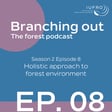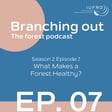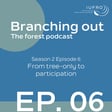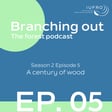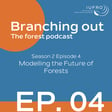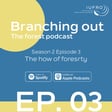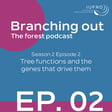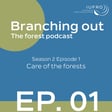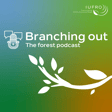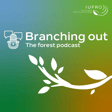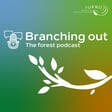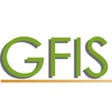Biodiversity Hotspots in Southeast Asia and Madagascar
00:00:01
Speaker
What does Southeast Asia, especially Malaysia and Indonesia, Madagascar, the Andes, Central America and the Caribbean, just to name a few, have in common? They are biodiversity hotspots. The regions characterise both by exceptional levels of plant endemic, meaning species that only grow there, and a particularly vulnerable environment.
Introduction to 'Branching Out' Podcast
00:00:28
Speaker
Welcome to Branching Out, the forest podcast where we connect forests, science and people, brought to you by the International Union of Forest Research Organisations, IUFRO. Let's discover the role of forests and trees for people and nature while we unravel complex forest topics and keep you up to date with forest research.
00:00:45
Speaker
So far, we have covered journal information about the EU for World Congress 2024, in a so-called forest resilience and adaptation, and responsible forest bioeconomy.
Forests: Biodiversity and Ecosystem Services
00:00:54
Speaker
And we will talk today about diversity, because forests are home to most of the biodiversity online. That is, all the life forms found in forests. But just the trees, but other plants, animals and microorganisms, and yes, their DNA, which we have already mentioned in our second episode.
00:01:11
Speaker
And quite importantly, we will also talk about ecosystem services, meaning all the benefits the forests provide to society, because they are closely linked to biodiversity.
Meet the Hosts: Jose Valleños and Peter Edwards
00:01:19
Speaker
I'm your host, Jose Valleños, from my UFO headquarters, and today here with me, the co-host is Peter Edwards from Manaki, Fenua, I got that right, Landcare Research New Zealand, welcome Peter.
00:01:31
Speaker
Hello, Jose. I'm delighted to be here with you today. As a bit of background for our listeners, I'm a senior researcher at Manaki Fenno Landcare Research, one of New Zealand's state-owned research institutes. My work primarily sits at the interface of humans in the natural world, particularly forests. And as a social scientist, I work a lot with policy, for example, how to properly incentivize forest restoration and planting and
Impact of Deforestation and Biodiversity Loss
00:01:55
Speaker
How do we take a lot of this great fundamental forest research that's being done and ensure that it gets to the right people who are going to be able to use those outcomes? Ecosystem services are one of those things that I try to work with policymakers to encourage them to think beyond the physical products with the services that forests provide too.
00:02:14
Speaker
So what exactly is the problem? The problem is that we're losing biodiversity, and this has negative effects on other ecosystem services. Deforestation and forest degradation, i.e. forests that can no longer support their functions well, continue to take place at alarming rates, which contribute significantly to the ongoing loss of biodiversity. And its loss reduces nature's resilience, which we spoke about in our second episode, unless it becomes more vulnerable to the impacts of climate change.
Climate Change and Biodiversity Crises
00:02:44
Speaker
Sally Aitken, a UFO scientific achievement awardee at the 2014 World Congress and project leader of two large-scale projects studying adaptation, namely ADAPTREE and COADAPTREE at the University of British Columbia, is here to give us a perspective on forest ecosystem services, how they are interconnected, and consequences of a decline in forest biodiversity. Welcome, Sally. Please, tell us how big of an issue is this really?
00:03:12
Speaker
Well, we're facing twin crises of climate change and biodiversity loss. And both of these issues are really impacting species around the world and ecosystems around the world. And it's challenging to find solutions for both the biodiversity loss and for climate resilience.
00:03:34
Speaker
climate change adaptation. These are huge issues, especially in western North America. We've seen enormous losses of forests due to forest fires, droughts, and certainly these accelerated by climate change have had huge impacts on biodiversity as well.
Forest Biodiversity and Ecosystem Resilience
00:03:52
Speaker
Can we consider forest biodiversity key for ecosystem services? How does one link to the other?
00:03:59
Speaker
The forest trees we find in forest ecosystems are foundation species. That is, you don't have a forest without that architecture. And having a diversity of species really creates many different habitats for other aspects of biodiversity, the other plants and animals that live in forests.
00:04:19
Speaker
But diversity also creates resilience against environmental change. And of course, as humans, we're relying on forests as well for ecosystem services, including carbon sequestration, clean water, clean air, and all of the other services that forests provide. And all of those are dependent on having healthy and resilient forest ecosystems.
00:04:46
Speaker
In which ways can research on biodiversity and ecosystem services contribute to sustainable forest management practices and the sustainable development goals?
Research and Forest Sustainability
00:04:56
Speaker
One of the key areas for researchers to better understand the carbon sequestration and the distribution of carbon in forest ecosystems, and also the fluxes that are happening with the changes we're seeing with forests globally. And one of the big questions is, for example, soil carbon. Soil carbon relates directly to soil biodiversity. So these are really frontiers of exploration, if you will.
00:05:23
Speaker
Other areas are how can we assist the adaptation of forest to new conditions? Because what we have are assemblages of species that are adapted to past conditions, past climates, and that makes them vulnerable to the extremes we're seeing in climate right now. And so are there ways that we can assist that adaptation to new conditions without
00:05:53
Speaker
severely disrupting those systems in the process these are very difficult questions we can look at force diversity and think about how we are restoring those ecosystems how to incorporate more diversity in those ecosystems of possible species and genetic diversity because it's very difficult
Genetic Diversity and Climate Adaptation
00:06:13
Speaker
forecast what species and what populations will do well under future conditions. There's a lot of research going on in that area, especially on the species side through species distribution modeling, but also incorporating that work with genetic analyses and understanding the capacity of populations to adapt to new conditions.
00:06:37
Speaker
So, we really need to combine these different tools at species levels and genetic levels to understand if we are planting trees for restoration or for reforestation, what the likely
00:06:52
Speaker
conditions are going to be, but also buffering those predictions of future conditions because we don't know exactly what climate trajectory we're on. We don't know what other insects, diseases are going to invade these ecosystems. So there's many things to think about, many ways that research can contribute to better understanding how we can generate more resilience in these systems.
00:07:18
Speaker
That's already a great introduction to our next guest who will speak more about genetic resources. But before we move on, you will be a keynote speaker during the World Congress next year. Could you tell us what we might expect from that presentation? We need to change our perspectives on managing diversity in forests.
00:07:37
Speaker
whether those are more conservation or multipurpose forests or whether those are more tree farms for fiber. We need to embrace species diversity and keep a very close eye on genetic diversity and manage genetic diversity in those systems because of the uncertainty that we're facing. And we need to be very careful about relying on forests for our future
00:08:04
Speaker
carbon sequestration to help us deal with climate change because climate change is moving at a pace where forests in many areas are giving off more carbon than they are sequestering because of extreme climate events. So we need a lot of research in all of these areas and we need fundamental shifts at least some parts of the world in how we manage forests. Thank you.
00:08:29
Speaker
Thank you, Peter and Sally. Next, we would like to discuss some efforts being made to conserve and manage another important aspect of biodiversity, forest genetic resources with Mariana Westengren from the Slovenian Forest Institute and deputy coordinator of the physiology and genetics division of
Role of Forest Genetic Resources
00:08:46
Speaker
Ayushro. Hi, Mariana.
00:08:47
Speaker
Hi, thank you for having me here. I think I have to explain you actually what horror genetic resources are. The term refers to all genetic diversity of actual or potential value between and within species with a continuum from domestic gene pools, wild gene pools.
00:09:06
Speaker
And in forestry, domestic gene pools would mean varieties or trees that are bred for plantation forestry. And wild gene pools would mean wild populations. Actually, the majority of global forests today are undomesticated.
00:09:23
Speaker
And genetic diversity, it's the cornerstone of all diversity, the ones that we see and the ones that we don't see. So there would be no ecosystem services without forest genetic resources. How does forest genetic resources contribute to the adaptation of forests in the face of changing environmental conditions, mainly climate change, and to securing other ecosystem services?
Adapting Forests to Change: Genetic Potential
00:09:48
Speaker
We need to understand that forest tree species grow in very different environments and that they have been growing in these different environments for a very, very long time. So the same tree species, for example, if I take sassile oak from Europe, which grows almost across the entire continent, will have both populations in drier and warmer climate and in cooler and wetter climates.
00:10:15
Speaker
So the populations of these same three species, which we often call provenances in forestry, will survive and they will thrive in different environments. And they will carry adaptations to these environments because they have been growing there for a long time, adapting over generations, at least since the last Ice Age.
00:10:35
Speaker
If there is enough genetic diversity for natural selection to act upon, they will be also able to adapt now and in the future. Now the tricky part is whether there is enough time for this adaptation to occur. Are there untapped potentials of forest genetic resources in maintaining ecosystem services?
00:10:54
Speaker
Yeah, absolutely. There is really a lot of untapped potential hidden in the forest genetic resources. If I take Europe again, because I'm coming from Europe, in continental Europe, there are 265 native tree species. And we only know the distribution of genetic diversity for a few dozen of them.
00:11:13
Speaker
and knowledge about this genetic diversity, how it translates into adaptation, into better growth, into resistance to diseases and other ecosystem services. It's even sparser, a lot of modeling. And there are also some trials underway, but much more effort is actually needed to validate the results of these models and to test them in less studied or unstudied tree species. Experiments are being carried out.
00:11:39
Speaker
new experiments are being established, for example, also in a Horizon Euro project called OPP Forests, where we are looking at species and provenance mixtures together and trying to discover their hidden reaction norms.
00:11:54
Speaker
How can a better understanding of forest genetic resources lead to more diverse and sustainable uses, particularly in the context of climate change adaptation and mitigation?
Genetic Diversity in Sustainable Forest Use
00:12:04
Speaker
For example, in a declining forest, foresters would often think that the solution to a healthy forest again that provides all the desired ecosystem services would be to change the declining tree species. Now, sometimes this may be the best option, but often the same goal can be achieved just by replacing the provenance.
00:12:24
Speaker
We would certainly disturb the habitat of associated organisms to a lesser extent. There would be no danger of the species becoming invasive and also we wouldn't be changing the livelihoods of communities of people living in or from this forest.
00:12:41
Speaker
If we take forest genetic resources from drought tolerant populations, we can incorporate them into breeding programs and making the new generation of trees more drought resistant. And this is the case actually what is happening in maritime pine. The French breeding population is being infused with the genetic diversity from the Corsican population because the Corsican population is more drought tolerant.
00:13:06
Speaker
also with the increased movement of people and goods. Environmental conditions are changing on one side and then new pests are spreading and we can look for tolerant or resistant trees in the forest, put them in the same place, make a breeding population and plant the offsprings coming from this breeding population back into the forest, making the forests more resistant. And this is exactly what is happening with the ash in Europe. Finally.
00:13:32
Speaker
What are the keys that it is in safeguards required to ensure responsible use of genetic resources, including equitable sharing of benefits and protection of traditional knowledge? I think it's really good that there are safeguards and the legislation to protect the genetic resources and traditional knowledge so that local communities actually have benefit from their genetic resources. But what I actually think that the key is
00:13:56
Speaker
to the responsible use of forest genetic resources. I think it's knowledge and it's accessibility and open sharing of that knowledge. Thanks a lot for your time here at branching out, Rania. Thank you for inviting me and letting me share a bit of my views on forest genetic resources and their connection to ecosystem services.
00:14:16
Speaker
Current negative trends in biodiversity and forest ecosystems will undermine the progress towards the UN 2030 Agenda for Sustainable Development, and specifically Sustainable Development Goal 15, which is devoted to protect, restore and promote sustainable use of terrestrial ecosystems, sustainably managed forests,
00:14:37
Speaker
combat desertification and halt in reverse land degradation and halt biodiversity laws. To illustrate this, here is KMA Bandra, Conservative General of Forest from Sri Lanka, where I use her special programme for development of capacities together with local partners promoted a forest landscape restoration project.
00:14:56
Speaker
Can you briefly describe the forest landscape restoration project that you've been involved in?
Sri Lanka's Forest Restoration Project
00:15:01
Speaker
Basically what we have done is we trained our forest officers and the related other officers in the forest landscape area. And after that, using those trainers, we have done several training programs for field officers who are doing the practical work on the field. So we trained around 400
00:15:21
Speaker
people, field officers to do this work in the field. So that is how we have done the training program. Actually, this is a practical work. So we have done three practical training programs for project areas. We identify three project areas. One is dry zone of the country. The other two training programs are done in the better part of the country. We have developed three management plans for all those three project areas.
00:15:50
Speaker
Those are the three areas we have done in our forest landscape restoration project. We've implemented all those training programs so that we have the training manuals now with us and we have developed those management plans for three landscapes. So we are having three management plans with us. We have translated some of those training materials to local languages, basically Sinhalese and the Tamil language. So we have
00:16:13
Speaker
training materials as well as the management plans. We have removed some of the invasive alien species from the forest. We have done some income generation work for surrounding areas of the people who are living around the forests. And we have developed some of the ecotourism activities or the income generation activities those forest petals.
00:16:32
Speaker
Using those skills we were able to protect the forest areas. First thing is to protect and improve the forest areas using this forest landscape restoration. And what were the key biodiversity-related goals and objectives of this forest landscape restoration project?
00:16:50
Speaker
One of the major threats we are having in the biodiversity is the spread of the invasive alien species in those forest areas. The places we have selected for this project, some of the areas were completely invaded with this invasive species. The scientific name of those species is Lantana camera. Because of that, the animals cannot move through the forest. So what we have done in this project is remove all of those invasive
00:17:20
Speaker
area species. That has reduced the pressure by these invasive species and it had a positive impact of the biodiversity and positive impact. Have you already seen some results from the restoration efforts? And how did these changes impact forest ecosystem services in the area?
00:17:38
Speaker
At the livelihood development of the rotor people around the forest, we have given some term generation activities within their home gardens by incorporating some of the agriculturally important species such as fruit species, some of the commercial timber species.
00:17:57
Speaker
as well as some of the other relatively important species, we have included their own gardens. So, gardens in the future, so it definitely impacted positively for biodiversity conservation within our forests. And the second thing is the ecotourism activities. We have generated some of the ecotourism activities. Because of the removal of these invasive species, they are having free access to the area. That means the elephant has very good access to the area.
00:18:27
Speaker
the first thing, and because of that thing, the number of visitors for that eco parts, the areas we have all as eco parts, the income of the eco parts are very high. In your view, what are the key ingredients for the success of a forest landscape restoration project in terms of biodiversity outcomes?
00:18:46
Speaker
All the key things we have identified in this project is that definitely we have to have a very good legislative and the policy support for this program. So if the policy is there, that means the forest area will be remain as it is.
00:19:01
Speaker
It will not be converted to other land use patterns. So that is the basic thing we have to have at the beginning. And we have to have a very clear objectives and the task and the holistic plan and involvement of the all important stakeholders in the planning stage. Thanks, Pandara. And let me remind our listeners that the SPDC will have a range of activities related to forest landscape restoration plan for the exhibition area at the IUFRA World Congress 2024.
00:19:29
Speaker
Biodiversity conservation and sustainable forest management need effective governance, integrated policy for interrelated issues, land tenure security, respect for the rights and knowledge of local communities and indigenous peoples, and enhanced capacity for monitoring as well as innovative financing modalities.
00:19:49
Speaker
Nazmul Sadat from the Kurna University in Bangladesh, who works on tropical forestry, policy and governance, and he is also deputy coordinator for the Community Forestry, Forest Policy and Nature Conservation Division of Ayufro, is here to give us some insights into the topic of society's role in biodiversity conservation.
Society's Role in Biodiversity Reversal
00:20:08
Speaker
Welcome Sadat, how critical is it for society to reverse pressures on forest biodiversity and forest loss?
00:20:14
Speaker
It is critical nowadays because especially I am from the tropics. So in tropics the deforestation rate is so high and with the deforestation the forest biodiversity is going down. When you lose the diversity then you lose these forest services from the forest. What in one hand the national economy loses from many sides. You can talk about from ranging from the genetics to the medicine to the diversity of products and on the
00:20:38
Speaker
other hand, the subsistence and livelihood of the local people, there are a huge number of populations that depend on the forest. So when you lose the diversity, you have the chance of that their livelihood might be at risk. And what has been gone to reverse the pressures leading to forest loss? What has been more effective?
00:20:56
Speaker
even already declared this is the decade of forest landscape or ecosystem restoration so every country is abide by that they're trying to do their own things like other countries my country is also doing this the first thing is for to reverse this situation should be we have to change our forest management regime from one to another like one is converting the forest and the high yielding timber production towards a little bit more in biodiversity conservation and people's participation should be there if you cannot
00:21:25
Speaker
Get people on board. You cannot be successful in any kind of restoration project. Speaking of people, how can different stakeholders collaborate? Talk about stakeholders. In policy terms, we actually have a thin differentiation in between the stakeholders and the actors. You know, somebody is taking decisions and somebody is also impacted by the decisions.
00:21:44
Speaker
So, the collaboration is imperative for making the forest landscape restoration successful. So, in that collaboration, you have to find a situation where everybody thinks that they get something. So, they win something. Like, if you do not give something in your restoration component, that means species-wise or plantation-wise or monetary-wise, incentive-wise to the local people, they will not support you. If they do not support you, then you cannot fight the deforestation by illegal means because they need the people. Because, you know, most of in
00:22:13
Speaker
In the tropics, you will find the forest gods alone cannot protect the forest. So, you need a wholehearted people's support to get that you have to talk to them meaningfully, I would say meaningfully, not just for talking. Get their impression, get their interest in your account, what they are actually looking from the forest. Are they looking only protection? That's fine. Are they looking some kind of subsistence livelihood from the forest? Then you have to accommodate, you have to choose the component of your forest
00:22:42
Speaker
scientifically taking the considerations of the people's wheel and design your restoration package.
Collaborative Stakeholder Efforts in Restoration
00:22:48
Speaker
I can give you one short example because we are short in time. What we are doing in Bangladesh right now, it's a big project called Shufal, which is for sustainable livelihood and forest restoration, together they are addressing. I was responsible for their big of like let's say 40,000 hectare forest land restoration planning.
00:23:05
Speaker
So we bring in called SSB site specific planning. So what we did there, we assess the land, we assess the historical data. That's what first was there. Now the present conditions, the environment, and also we talk with the people. We had the beneficiaries there. We had them.
00:23:20
Speaker
multilevel stakeholders from the grassroot to the upper level, what the forest department is looking for, what's their will, and what the people are looking for. Then we prescribe for a particular forest bid as what kind of restoration project should be there, depending on the forest condition and the people's will. If we focus on challenges, potential barriers, what are the major approaches to restoration?
00:23:44
Speaker
This is a very good question. I was waiting for this question because my IFR session is on one of the challenges because my session is dealing with SDG and in other hand forest conservation I'm looking at from the policy lenses because you know in the tropics SDG is a big thing so you have to satisfy all the goals here.
00:24:02
Speaker
especially one two and three is a very important goal which is dealing hunger and prosperity and on the other hand the forest is a resource and there are goals also which is talking about the conservation of forest so you have to calibrate it so it the challenge is one and in one hand is how much trade-off you can do in some cases you will find there is conflicting in between the two goals of Aries teaches and some there will be synergies but synergies is good for the forest but where there is conflict you have to come at some sort of trade-off you have to live away some sort of the aspect of the forest and you have to live away some
00:24:32
Speaker
of the development. So this is one of the biggest challenge of keeping with the development goal of a country, economic development and meaning industrialization. I am talking about the tropical countries and added on this climate change challenge and having the forest back. So this is a big challenge. You have to synchronize it in such a way you have to find the correct trade off. That's in my opinion is the biggest challenge for having our forest back.
Valuing Biodiversity and Ecosystem Services
00:24:57
Speaker
Thank you very much Sadat and thanks to all of our guests and listeners. Before we go, I always have to take home message. So Peter, what is your take off message for today? From my perspective, one of the key take home messages from today is that we need to recognize the dent of biodiversity and the services that forests provide beyond the physical products. It help us as humans and
00:25:22
Speaker
We need to really, really need to sustain and manage those, particularly in the light of climate change. Thank you very much, Peter, again, for being here. And, you know, you can listen to Branchenau wherever you listen to podcasts, and you can rate us, review us, and the next time we will explore the topic of forests for sustainable societies. And check out more content from Ayufro at ayufro.org or click on the link on the show notes. Thanks. Bye-bye.

